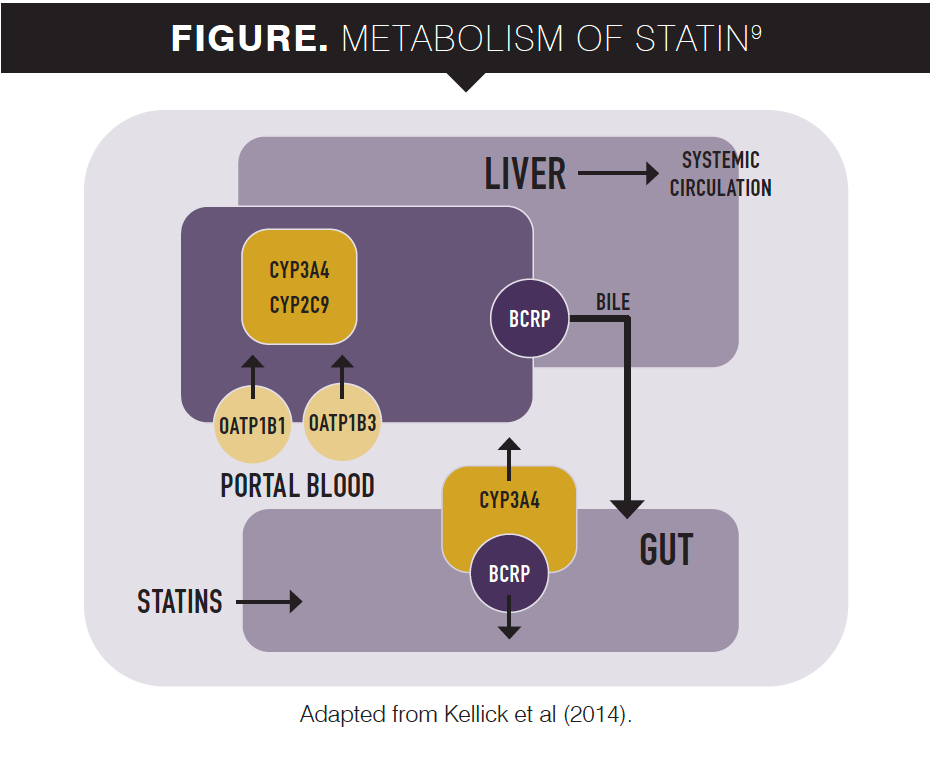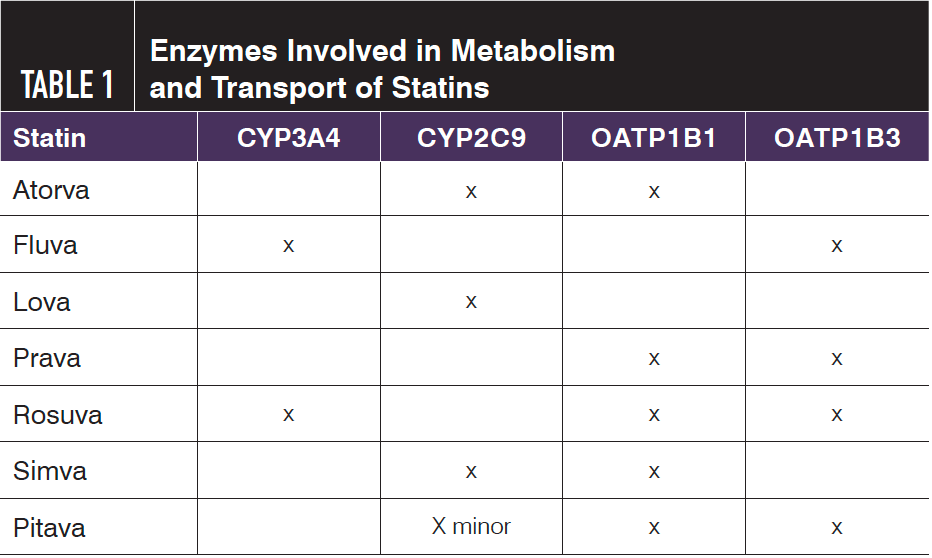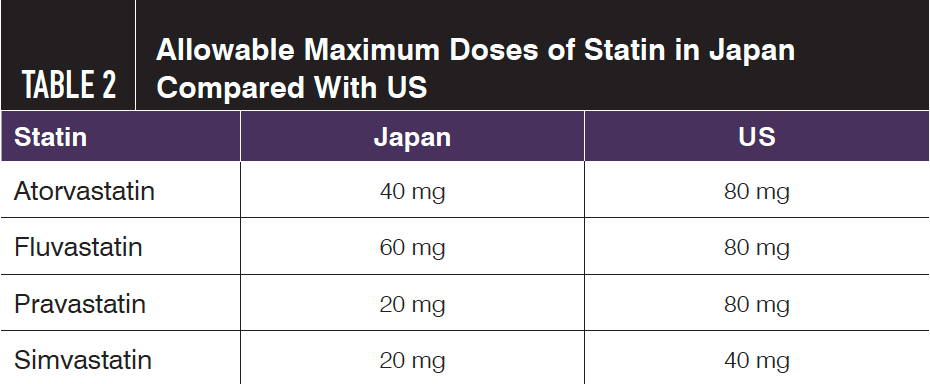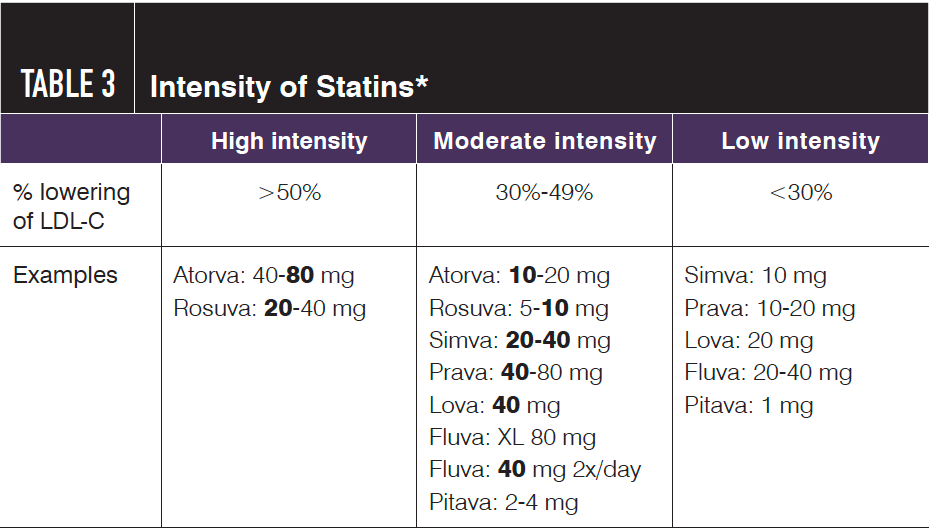Statin use in midlife women
Risk assessment, lifestyle counseling, adverse effects, and medication management.
Cardiovascular disease (CVD) is the leading cause of mortality and morbidity for women in the United States. Ninety percent of women have 1 or more risk factors for developing CVD. Among women and men aged 40 years, there is an equal prevalence of CVD, and by the time they are aged 60 years, more women than men have heart disease. Nonetheless, CVD remains understudied, underdiagnosed, and undertreated in women.1
Although myocardial infarction (MI) in women occurs predominantly in those aged more than 65 years, it is does occur in younger women as well. In the United States, more than 100,000 women younger than 65 years have an acute MI each year, representing 21% of all acute MI cases in women.2 Additionally, risk of myocardial infarction in pregnant women has risen significantly (by 25% between 2002 and 2014), in part related to older age at conception and to accompanying risk factors such as hypertension, hyperlipidemia, diabetes, and obesity.3
Following an MI, female sex is an independent predictor for 30-day readmissions after acute coronary syndrome (ACS) that requires percutaneous coronary intervention. Women are at a higher risk of post-ACS cardiac events such as heart failure and recurrent ACS.4 Regardless of age, more women than men die in the first year following an MI (26% vs 19%) and suffer from heart failure following their first MI (46% vs 22%).5
In addition to traditional CVD risk factors, unique risk factors should be considered in women; in some cases, age of menarche, gestational history, and onset of menopause (natural or surgical) can increase the risk of developing CVD and experiencing a cardiac event. Also, autoimmune diseases, such as systemic lupus erythematosus and rheumatoid arthritis, are more common in women and significantly increase a woman’s risk of premature CVD and heart disease.
Additionally, traditional CVD risk factors, notably hypertensive disease and dyslipidemia, increase after menopause. With the loss of estrogen, blood vessels stiffen; this promotes increases in blood pressure (86% of women aged more than 75 years develop hypertension), and insulin sensitivity often decreases. Adverse lipid changes following menopause are associated with plaque development, rising low-density lipoprotein cholesterol (LDL-C) and triglycerides values, and declining high-density lipoprotein cholesterol (HDL-C) levels.
Step 1: Assessing risk
Assessing a woman’s CVD risk early in life is critical. Women with high risk should have their lipid panel and lipoprotein (a) checked by age 20 years, sooner if a family history of early heart disease exists. If test results are normal, reassessment can occur every 5 years; however, if initial testing is abnormal, further diagnostics may be indicated to evaluate CVD risk before implementation of treatment and follow-up. Notably, individuals with autoimmune disease may appear to have normal lipid profiles when in an autoimmune flare. Reassessment of these individuals when they are not in a flare is critical to ensure that hyperlipidemia or other risk factors do not go unrecognized.
Traditional risk factors such as family history, smoking, inactivity/sedentary lifestyle, diabetes, hyperlipidemia, hypertension, obesity, obstructive sleep apnea, autoimmune issues, and stress are important to recognize and address. Women who began menstruating before age 10 years or after age 17 years have a higher incidence of CVD.6
Pregnancy is considered a women’s first stress test, and many women do not pass it—although often they don’t know it. Women who develop adverse pregnancy outcomes such as hypertensive diseases of pregnancy (eg, preeclampsia), gestational diabetes, or fetal growth restriction are at increased risk of developing early CVD, regardless of their cardiometabolic risk otherwise. Women with cardiometabolic issues are at an even higher risk of cardiac disease if they develop adverse pregnancy outcomes.
Once a thorough history has been obtained, further risk assessment can be achieved using the atherosclerotic cardiovascular disease (ASCVD) Plus or Reynolds risk assessment tools. A 10-year CVD risk of 7.5% is considered significant. If patients have a family history of premature coronary heart disease, significant hyperlipidemia, diabetes, autoimmune disease, or hormonal or gestational issues, but have predicted scores less than 7.5%, consideration for further testing, including high-sensitivity C-reactive protein and coronary artery calcium (CAC) scoring, can be very useful. With these data, a third risk assessment, the MESA Risk Score, can be calculated. A CAC score of 0, portending a very low CVD risk within the next 10 years, is very helpful when counseling patients regarding the management of risk factors, particularly cholesterol and statin use. One caveat regarding the CAC score in women is that some women have soft plaques that are not apparent on a CAC study; therefore, women with significant cardiac risk factors need to be treated accordingly in the face of a negative CAC study.
Step 2: Lifestyle counseling
Once the CVD risk assessment has been completed, the next step in counseling is to evaluate lifestyle components. Diet and lifestyle change are the initial and most crucial components of managing CVD. The foundation of CVD prevention begins with assessing daily and/or weekly eating habits. The use of dietary recall to evaluate a weekday and weekend meal plan can be used as a springboard for discussion. The most well-researched eating pattern for heart health is the Mediterranean diet. The 5-country study, initiated in the 1960s, was able to identify universal risk factors for CVD, which included blood pressure, cholesterol, diabetes, and smoking. The study also identified communities that had a lower risk for CVD and all-cause mortality based on their eating pattern, later coined the Mediterranean diet.
The Mediterranean diet encourages an eating plan based on whole foods, incorporating daily consumption of olive oil, fruits, vegetables, legumes, and whole grains; weekly intake of fish, fermented dairy, and eggs; smaller portions of meats, which don’t include processed meats and limit red meat; and small portions of wine served with the dinner meal.
The benefits of the Mediterranean diet eating pattern are derived from the interconnectedness and interplay of the ingredients that are high in phytonutrients and antioxidants. Increasing the components of the diet in an individual’s eating pattern by 2 points on the Mediterranean diet scale can decrease overall mortality by 25%.7
In addition to evaluating the patient’s baseline eating habits and discussing their desire to make changes in their habits and their confidence to do so, it is important to determine their baseline exercise pattern as well as other risk factors such as smoking.
Step 3: Medication management
The mainstay of medical therapy for either CVD prevention or treatment is statin therapy. Statins inhibit the 3-hydroxy-3-methylglutaryl-coenzyme A reductase enzyme, the rate-limiting step in cholesterol synthesis, and thus cholesterol production is decreased and subsequently LDL hepatic receptors are upregulated. Typically, statins will lower levels of LDL-C, non–HDL cholesterol, and apolipoprotein B. They will have a variable effect on HDL and triglycerides. Statin efficacy, like that of all other drugs, relates to the drug’s pharmacokinetics and pharmacodynamics, including method of absorption, area of distribution, metabolism, and method of excretion. Understanding the differences among the statin choices can help manage adverse effects (AEs), such as myopathy and drug-drug interactions, and allow the clinician to feel more comfortable interchanging the statin choices.
Prior to starting statin therapy, assessing fertility status in women of reproductive age is important. The FDA recently changed its guideline to allow continuation of statins in pregnancy, but not during breastfeeding; however, a discussion about risks vs benefits of statin continuation during gestation is critical. Many women on statins have comorbidities that increase their risk for genetic anomalies and miscarriage, and it appears from the very limited research to date that the associated comorbidities and not the statin itself increase fetal risk.8
Figure. Metabolism of Statin9

Initiating statin therapy is an important step in managing a woman’s CVD risk within an ob-gyn practice. Today, women are presenting with comorbidities and risk factors at much earlier ages. Having a reasonable understanding of the differences in statins can help ensure successful lipid management in women. As the Figure depicts, a statin that is not metabolized on the local level of the intestinal cell is transported via the portal circulation to the hepatocyte.9 Entry into the hepatocyte is partially controlled by the organic anion transporting polypeptide (OATP1B1 or OATP1B3) substrates, which allow transport of the statins into the hepatocytes from the portal circulation. A genetic polymorphism for the OATP1BB1 transporter encoded by the SLCO1B1 gene does exist and increases the risk of myopathy.9
Table 1. Enzymes Involved in Metabolism and Transport of Statins
Adapted from package inserts.

Once the statin has entered the hepatocyte, it is rapidly metabolized via the cytochrome P450 (CYP) system (Table 1). Simvastatin, lovastatin, and atorvastatin are metabolized by CYP3A4, whereas fluvastatin, pitavastatin, and rosuvastatin are metabolized by CYP2C9. Pravastatin is not metabolized by an CYP450 isoenzyme family.
Table 2. Allowable Maximum Doses of Statin in Japan Compared With US

The statin is excreted from the hepatocyte in several ways; however, breast cancer resistance protein transporter is an important one. Of all women of Asian descent, 35% to 45% will carry mutations in this transporter, which leads to increased levels of toxicity and AEs at much lower statin doses. However, this mutation is found in only 1% to 4% of the Black population and 5% to 10% of the White population.10 Translating these genetic polymorphisms into clinical practice guides the clinician to start with lower doses in Japanese women (Table 2). Additionally, lower starting doses of statins, or the use of alternative medications, should be used in patients sensitive to muscle AEs.
Several important drug interactions with statins exist. There is an absolute contraindication of statins with gemfibrozil (an inhibitor of OATP1B1 and an inhibitor of glucuronidation of all statins), and an interaction with warfarin (etiology unknown) that causes a mild increase in the international normalized ratio. Furanocoumarins, which are found in grapefruit juice, can interfere with the CYP3A4 system; however, this is a minor interaction, and if the grapefruit juice is consumed in the morning and the statin medication is taken at bedtime, the impact is minimal.8
Statin AEs: What are the risks?
Understanding the mechanisms by which the different statins are metabolized help both provider and patient choose an appropriate initial therapy as well as subsequent therapy if AEs develop.
1. Myalgias
Compared with men, women are an estimated 1.5 to 1.7 times more likely to have clinically adverse drug reactions. Women tend to develop CVD later in life, and thus have several complications that can arise because of the aging process, including lower body muscle mass, polypharmacy, and higher insulin resistance. Sex-based differences in pain perception have also been noted in the literature.11
Women are also known to have higher concentrations of CYP3A4, which results in faster metabolism of the 3A4 statins (atorvastatin, lovastatin, simvastatin), potentially contributing to muscle symptoms. Also, women have a higher fat mass than men, so distribution of the lipophilic statins (lovastatin, simvastatin, fluvastatin, atorvastatin) along with an increased concentration of CYP3A4 can lead to differing timing and amounts of active drug in women, which can complicate muscle AEs.12,13
Patients can experience myalgias without affecting transaminase values or renal function, but these AEs will most likely lead to discontinuation by the patient.
2. Diabetes
The development of type 2 diabetes (T2D) is a 2-step process that develops over several years. The underlying process is initiated by the development of insulin resistance; this requires greater insulin output and ultimately, over time, B-cell decline. Statins, as a class, do increase insulin resistance to a small degree in a dose-related effect. Therefore, higher-dose statins have a higher risk for “tipping” a patient who is predisposed to diabetes into a diagnosis of the disease. The risk for developing T2D does not exist for all patients, and only about 10% to 15% of individuals with predisposing risks (eg, body mass index >30; fasting blood glucose >100 mg/dl; metabolic syndrome; glycated hemoglobin >6%) will develop T2D. This risk translates into 1 new patient developing diabetes of every 255 persons treated with a statin.12
3. Liver concerns
In 2012 the FDA removed the recommendation for regular checks for hepatic transaminases for patients taking statins. Experience with statins showed that the actual risk of liver failure was, literally, 1 in 1 million; additionally, liver failure was idiopathic and no preventive benefit was seen with regular measurements. Statins can raise transaminase levels in 1% of patients, but this generally occurs without a change in hepatic function or hepatocellular injury. The typical statin pattern will be the development of higher alanine aminotransferase levels than aspartate aminotransferase levels; while this represents hepatocellular release of these enzymes, it does not translate to hepatocellular injury. The current recommendations include checking transaminases prior to starting therapy and repeating afterward as clinically warranted, with no specific need to stop until and unless 3-fold elevation occurs.
The rising incidence of obesity and diabetes coincides with increased incidence of nonalcoholic fatty liver disease/nonalcoholic steatohepatitis (NAFLD/NASH). As women age, they lose the protective effect of estrogen, and their increase in CVD risk can be compounded by the presence of NAFLD/NASH. Women with cirrhosis have an increased mortality rate compared with men, yet lifesaving statin therapy is often stopped in the setting of NAFLD/NASH. Statins have been shown to be safe and effective in lowering LDL-C and CVD events in this population (and in people with other liver diseases) in whom transaminases are less than 3 times the upper limit of normal and the individuals meet ASCVD risk treatment recommendations.14,15
4. Memory
No evidence in the literature finds that statins worsen or promote dementia. In fact, in a recent meta-analysis, it was determined that statins decreased all-cause dementia by approximately 15%, Alzheimer disease by 28%, and mild cognitive impairment by 26%.16
5. Intracerebral hemorrhage
In the past, there had been some concern for hemorrhagic stroke in individuals who had a prior intracerebral hemorrhage (ICH). The results of 2 randomized clinical trials, SPARCL (NCT00147602) and HPS (NCT00461630), showed an increase in ICH, albeit the actual number of events was very small (7 events in the statin group vs 2 events in the nonstatin group in SPARCL). On the other hand, 3 observational trials found no association. More recent national registry evaluations show no evidence of increased risk of ICH in individuals on statin therapy with a prior history of ICH. Currently, no evidence exists to support the belief of an increased risk of ICH for patients on statins.17
6. Tendonitis
The prevalence for tendinopathy and/or possible rupture related to statin use is approximately 2%. Risk does increase with comorbidities, and caution should be observed in patients taking a statin along with other medication(s) that increase the risk of tendonitis, such as fluoroquinolones and steroids, as well as concomitant therapy.18
Shared decision-making
Table 3. Intensity of Statins*
LDL-C, low-density lipoprotein cholesterol.
*Bolded dosages have been used in clinical trials. Table adapted from package inserts.

CVD is the leading cause of mortality and morbidity in women, yet women continue to be underrepresented in clinical trials and underdiagnosed and undertreated in clinical practice.19 It is imperative—after risk assessment, lifestyle modification, a review of current medications and comorbidities, and fertility status—to initiate statin therapy in appropriately risk-stratified women.
In women who have increased risk of CVD but have had no event, the goal is typically to achieve an LDL-C level less than 100 mg/dL. In women who have had an event, such as MI or stroke (eg, cerebrovascular accident), the goal LDL-C level is typically less than 70 mg/dl. In women who have had recurrent events, the goal LDL-C level is typically less than 55 mg/dL. Knowing your patient’s risk and lipid goals can help you choose an appropriate intensity of statin (Table 3), knowing that high-intensity statins reduce LDL-C by more than 50% and moderate-dose statins reduce it by 30% to 49%. Even though laboratory changes can be seen after 4 weeks of treatment, it is reasonable to recheck the lipid panel at 3 months. It is not necessary to recheck transaminases unless the patient is symptomatic or has another clinical indication.
Women and men receive benefit from statin therapy. Given the increased mortality rates in women following a cardiac event, the benefit of statin therapy may be even greater for women than for men. The clinical literature supports the effectiveness of statins in women for CVD prevention and treatment. Statins have been proven safe and to have a low risk of complications.
Typically, women are their families’ primary caregivers, often neglecting their own individual health.20 It is our responsibility as health care providers to help women prioritize their own health, understand the risks and benefits of therapy, and assist them in choosing appropriate care. We must assess and educate women regarding their individual risk of CVD and advocate for treatment in a caring, engaging, and nonthreatening manner.
References
- Mosca L, Mochari-Greenberger H, Dolor RJ, Newby LK, Robb KJ. Twelve-year follow-up of American women’s awareness of cardiovascular disease risk and barriers to heart health. Circ Cardiovasc Qual Outcomes. 2010;3(2):120-127. doi:10.1161/CIRCOUTCOMES.109.915538
- Lloyd-Jones D, Adams R, Carnethon M, et al; American Heart Association Statistics
- Committee and Stroke Statistics Subcommittee. Heart disease and stroke statistics--2009 update: a report from the American Heart Association Statistics
- Committee and Stroke Statistics Subcommittee. Circulation. 2009;119(3):e21-e181. doi:10.1161/CIRCULATIONAHA.108.191261doi:10.1161/CIRCULATIONAHA.108.191259
- Smilowitz NR, Gupta N, Guo Y, et al. Acute myocardial infarction during pregnancy and the puerperium in the United States. Mayo Clin Proc. 2018;93(10):1404-1414. doi:10.1016/j.mayocp.2018.04.019
- Lam L, Ahn HJ, Okajima K, et al. Gender differences in the rate of 30-day readmissions after percutaneous coronary intervention for acute coronary syndrome. Womens Health Issues. 2019;29(1):17-22. doi:10.1016/j.whi.2018.09.002
- Mozaffarian D, Benjamin EJ, Go AS, et al; American Heart Association Statistics
- Committee and Stroke Statistics Subcommittee. Heart disease and stroke statistics--2015 update: a report from the American Heart Association. Circulation. 2015;131(4):e29-e322. doi:10.1161/CIR.0000000000000152
- Lee JJ, Cook-Wiens G, Johnson BD, et al. Age at menarche and risk of cardiovascular disease outcomes: findings from the National Heart Lung and Blood Institute-sponsored Women’s Ischemia Syndrome Evaluation. J Am Heart Assoc. 2019;8(12):e012406. doi:10.1161/JAHA.119.012406
- Trichopoulou A, Costacou T, Bamia C, Trichopoulos D. Adherence to a Mediterranean diet and survival in a Greek population. N Engl J Med. 2003;348(26):2599-2608. doi:10.1056/NEJMoa025039
- KaralisDG,HillAN,CliftonS,WildRA.Therisksofstatinuseinpregnancy:asystematic review. J Clin Lipidol. 2016;10(5):1081-1090.doi:10.1016/j.jacl.2016.07.002
- KellickKA,BottorffM,TothPP; The National Lipid Association’s Safety Task Force.Aclinician’sguidetostatindrug-druginteractions.
- J Clinic Lipidol. 2014;8(3 Suppl):S30-S46. doi:10.1016/j.jacl.2014.02.010
- Niemi M, Pasanen MK, Neuvonen PJ. Organic anion transporting polypeptide1B1:ageneticallypolymorphictransporterofmajorimportanceforhepaticdrug uptake. Pharmacolog Rev. 2011;63(1):157-181.doi:10.1124/pr.110.002857
- BhardwajS,SelvarajahS Schneider EB.Musculareffectsofstatinsintheelderlyfemale: a review. Clin Interv Aging. 2013;8:47-59.doi:10.2147/cia.s29686
- NewmanCB,PreissD,TobertJA,etal;American Heart Association Clinical Lipidology, Lipoprotein, Metabolism and Thrombosis Committee, a Joint Committee of the Council on Atherosclerosis, Thrombosis and Vascular Biology and Council on Lifestyle and Cardiometabolic Health; Council on Cardiovascular Disease in the Young; Council on Clinical Cardiology; and Stroke Council. Statinsafetyandassociatedadverseevents: a scientific statement from the American Heart Association.Arterioscler Thromb Vasc Biol. 2019;39(2):e38-e81.doi:10.1161/atv.0000000000000073. Published correction appears in Arterioscler Thromb Vasc Biol. 2019;39(5):e158.
- GheorgheG,TothPP,BungauS,etal.Cardiovascularriskandstatintherapyconsiderations in women. Diagnostics (Basel). 2020;10(7):483.doi:10.3390/diagnostics10070483
- ConnellyMA,VelezRiveraJ,GuytonJR,SiddiquiMS,SanyalAJ.Reviewarticle:
- the impact of liver-directed therapies on the atherogenic risk profile innon-alcoholic steatohepatitis. Aliment Pharmacol Ther. 2020;52(4):619-636.doi:10.1111/apt.15935
- DiStefano JK. NAFLD and NASH in postmenopausal women: implications fordiagnosis and treatment. Endocrinology. 2020;161(10):bqaa134.doi:10.1210/endocr/bqaa134
- ChuC-S,TsengP-T,StubbsB,etal.Useofstatinsandtheriskofdementiaand mild cognitive impairment: a systematic review and meta-analysis. SciRep. 2018;8(1):5804. doi:10.1038/s41598-018-24248-8
- Riisgaard Ribe A, Vestergaard CH, Vestergaard M, et al. Statins and risk of intracerebralhemorrhageinindividualswithahistoryofstroke.Stroke.2020;51(4):1111-1119.doi:10.1161/strokeaha.119.027301
- DerenME,KlingeSA,MukandNH,MukandJA.Tendinopathyandtendonrupture associated with statins. JBJS Reviews. 2016;4(5):e4. doi:10.2106/jbjs.rvw.15.00072
- PlakogiannisR,ArifSA.Womenversusmen:isthereequalbenefitandsafety from statins? CurrAtheroscler Rep. 2016;18(2):6. doi:10.1007/s11883-016-0562-9
- WeiMY,ItoMK,CohenJD,BrintonEA,JacobsonTA.Predictorsofstatinadherence,switching, and discontinuation in the USAGE survey: understanding the use of statins inAmerica and gaps in patient education. J Clin Lipidol.2013;7(3): 472-483. doi:10.1016/j.jacl.2013.03.001

Low creatinine-to-cystatin C ratio linked to postmenopausal muscle loss
March 20th 2025A new study finds that postmenopausal women with a reduced creatinine-to-cystatin C ratio experience decreased muscle volume and slower walking speed, highlighting its role as a potential biomarker for muscle health.
Read More
Intentional weight loss linked to lower mortality in postmenopausal women
March 11th 2025A recent study shows that intentional weight loss significantly lowers all-cause, cancer, and cardiovascular mortality risks among postmenopausal women, highlighting the importance of targeted weight management.
Read More
